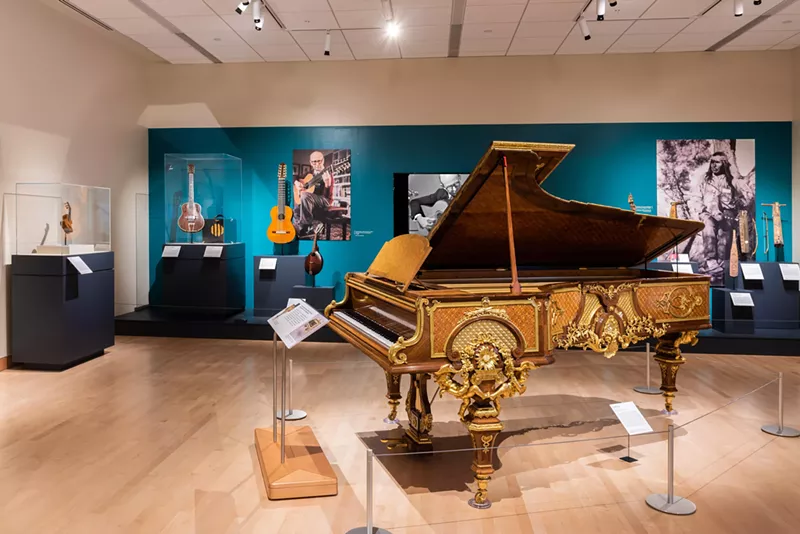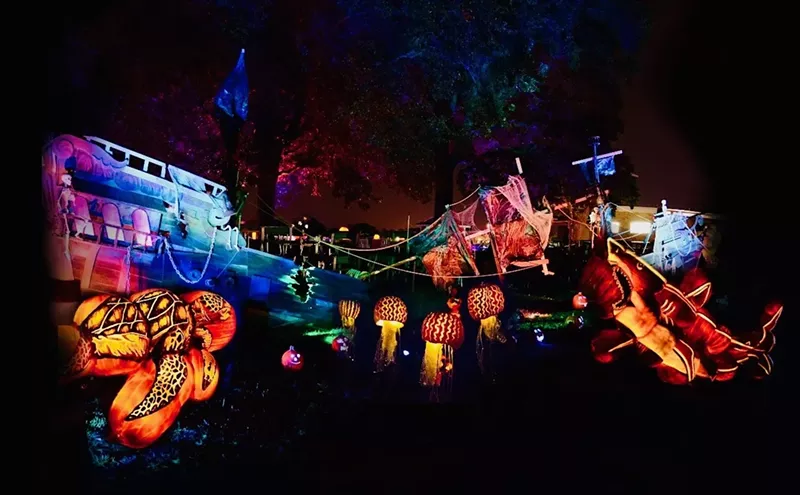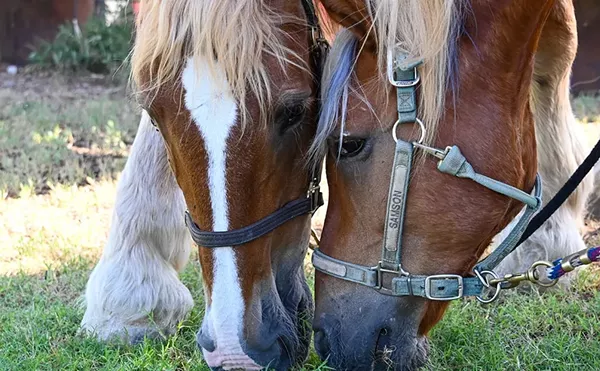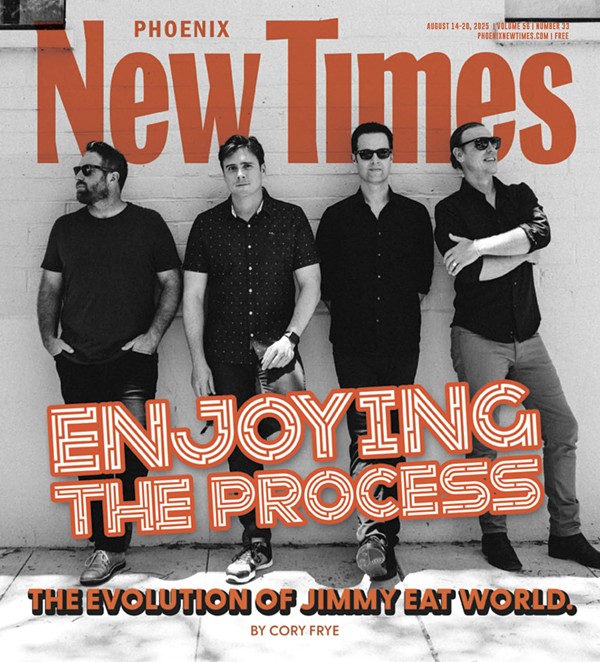The first electric guitar played in public. The first Hawaiian-made ukulele. Eric Clapton’s 1956 Fender Stratocaster, “Brownie,” which helped create his signature sound on classic songs like “Layla” and “Bell Bottom Blues.”
All of these and over two dozen new rare and precious objects will be on display starting on Friday, November 11, at the Musical Instrument Museum’s special exhibit, Rediscover Treasures: Legendary Musical Instruments. Twenty of the original 80 items from the previous iteration that closed in October, titled Treasures: Legendary Musical Instruments, were removed to make room for these 28 pieces.
The objects span time, geography, and cultures, and are the “best of the best,” says Rich Walter, MIM curator. They’re instruments that are “the most artfully created, [have] been in the hands of the most important people, and used in the most important settings.” He adds, “They’re the items that really stop us in our tracks when we see them.”
While the MIM’s regular collection is impressive, everything in this exhibit is “superlative,” Walter says. “We’ve asked people, ‘What does it mean to be a treasure?' That cross-section of answers is interesting ... Things that are fancy and decorative, things that have belonged to chiefs and rock stars, things that have been hard to find. There are examples of all of those throughout the gallery.”
He adds, “Each one of them has a real energy and gravity around it.”
Some instruments were created thousands of years ago, while others are contemporary, and all reveal exquisite craftsmanship. One item Walter is excited about is a Chinese bronze bell that’s about 2,500 years old. These items “help us understand musical traditions from around the world, but they’re artful objects,” he says.
Other objects include one of four surviving examples of an early pedal harp, a figurative carved drum from Gabon on the west coast of central Africa, and a Japanese emperor’s hitoyogiri flute from the 14th century. Walter says all of the instruments are “stunningly well-preserved, so you’re not only getting a sense of history, but the artistic ability, the tastes, the aesthetics, from cultures around the world.”
Of course, he understands that many people will be jazzed about the more recent pieces, including Clapton’s guitar and items that belonged to Prince on loan from his home and studio, Paisley Park. The musician’s “Beautiful” purple Yamaha grand piano that he danced on during his Jam of the Year Tour in 1997-98 and a bright green stage outfit worn on tour in 1997 will be there, along with his “Black Power” electric bass. These items will remain on loan once the exhibit closes in fall 2023.
“They were very generous to loan three pieces that would represent his career from an interesting time,” Walter says. “A lot of those items just don’t circulate far from Paisley Park, so to have them here in Phoenix is cool for fans of Prince.”
More celebrity instruments added to this display include Dizzy Gillespie’s gold-plated Martin Committee trumpet with its distinctive angled bell and Lionel Hampton’s custom-made Deagan vibraphone.
Some items are firsts, such as the first electric guitar played in public on Halloween weekend, 1932, by bandleader Gage Brewer of Wichita, Kansas, and the first ukulele made in Hawaii, thought to be crafted by Portuguese immigrant Jose do Espirito Santo.
How do they know these items have the pedigree they say they have? Loans like these have come from peer collections that have done their own research or from private collections where the people “have devoted their lives to passionate study,” Walter notes.
Other instruments’ notability has been well-documented historically. For example, the 1889 Erard grand piano from the original exhibit — which ran from November 2021 through October 2022 — is one of the most lavish ever built. It was a statement piece originally displayed at the World’s Fair in Paris "where the Eiffel Tower was this amazing, brand-new landmark,” Walter says.
As with the rest of the museum, the instruments in Treasures Rediscovered aren’t static items sitting on a shelf. Audio and visual context is provided so visitors can actually hear and often see them being played.
“You can see on the monitors people playing these historic, rare objects and commenting on why they’re so important or shedding light on why they’ve been preserved so carefully over time,” Walter explains. “It’s so important to see how the instruments are played and hear what they sound like.”
He says it’s vital for the museum to be an immersive experience for visitors, adding, “We actually hope that by the time they get through the whole gallery, they’ll have a broadened sense that all of these are extraordinarily special, and they represent the best of their kinds for display.”
Rediscover Treasures: Legendary Musical Instruments. Opens Friday, November 11, and continues through fall 2023. Musical Instrument Museum, 4725 East Mayo Boulevard. Museum hours are 9 a.m. to 5 p.m. daily. Cost is $10 for the exhibit or $27 for the museum and the exhibit. Call 480-478-6000 or visit the Musical Instrument Museum website for tickets, information, and a schedule of the exhibit's opening weekend programming.

Audio By Carbonatix
[
{
"name": "GPT - Billboard - Slot Inline - Content - Labeled - No Desktop",
"component": "21251496",
"insertPoint": "2",
"requiredCountToDisplay": "2"
},{
"name": "STN Player - Float - Mobile Only ",
"component": "21327862",
"insertPoint": "2",
"requiredCountToDisplay": "2"
},{
"name": "Editor Picks",
"component": "16759093",
"insertPoint": "4",
"requiredCountToDisplay": "1"
},{
"name": "Inline Links",
"component": "17980324",
"insertPoint": "8th",
"startingPoint": 8,
"requiredCountToDisplay": "7",
"maxInsertions": 25
},{
"name": "GPT - 2x Rectangles Desktop, Tower on Mobile - Labeled",
"component": "21934225",
"insertPoint": "8th",
"startingPoint": 8,
"requiredCountToDisplay": "7",
"maxInsertions": 25
},{
"name": "Inline Links",
"component": "17980324",
"insertPoint": "8th",
"startingPoint": 12,
"requiredCountToDisplay": "11",
"maxInsertions": 25
},{
"name": "GPT - Leaderboard to Tower - Slot Auto-select - Labeled",
"component": "17012245",
"insertPoint": "8th",
"startingPoint": 12,
"requiredCountToDisplay": "11",
"maxInsertions": 25
}
]












